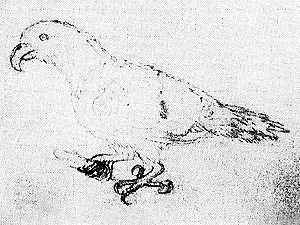Tanna Parrot (Prosopeia sp.)
There is a little account, or rather a kind of side note, that tells us of a parrot that once appers to have existed on the island of Tanna, Vanuatu. This little account from August 16, 1774 was made by Georg Forster on the island of Tanna, Vanuatu during James Cook’s second voyage around the world.:
“The next morning we came ashore again, and immediately walked into the woods on the plain. We saw a great number of large and beautiful parroquets, of black, red, and yellow plumage; but they kept on the tops of the highest fig-trees, where they were wholly out of the reach of small shot, guarded by the thick foliage.” [1]
***
Julian P. Hume thinks that this account most likely refers to a species of the genus Prosopeia, which otherwise is only known from the Fijian Islands. [2]
I personally, reading about the colors given in the account, do rather think that this account might rather be attributed to some kind of lorikeet, most likely from the genus Chalcopsitta or maybe Lorius, I will nevertheless maintain the name Prosopeia sp. given by Mr. Hume to avoid any confusions.
*********************
References:
[1] George Forster: A voyage round the world, in his Britannic Majesty’s Sloop, Resolution, commanded by Capt. James Cook, during the years 1772, 3, 4, and 5. London: printed for B. White, Fleet-Street; J. Robson, Bond-Street; P. Elmsly, Strand; and G. Robinson, Pater-noster-Row. Vol. II. 1778
[2] Julian P. Hume: Extinct Birds: 2nd edition 2017
*********************
edited: 11.02.2020


